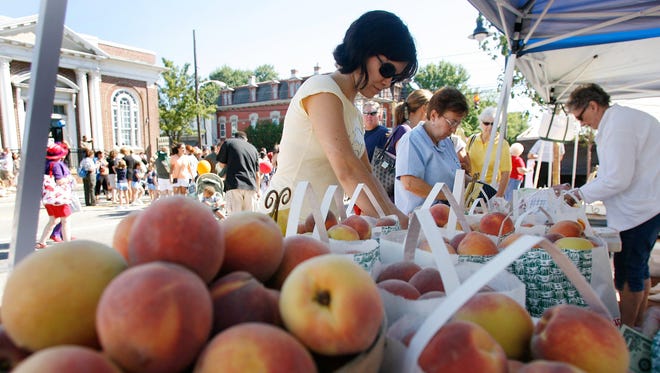Middletown Peach Festival: What you need to know

The Middletown Old-Tyme Peach Festival turns 25 this year, a quarter century of celebrating the historical and economic importance of peaches to the area.
The party, which closes off Main Street for booths and food, starts with a traditional parade featuring the marching bands of both Appoquinimink High School and Middletown High School.
Here’s our annual insider’s guide.
What you need to know: The festival runs 9 a.m. to 4 p.m. Saturday, Aug. 18 on several blocks of downtown Middletown, usually starting at Meredith Middle School. Admission is free. Highlights include fresh peaches and other food for sale, an 8:45 a.m. parade, kids’ activities, art and historical exhibits, a car show and vendors.
Street closures open up the town for the crowds (last year’s attendance was estimated at 27,000), and shuttles run around the festival and from parking areas at Redding Middle School, the Appoquinimink Public Library and Dutch Country Farmers Market. Details: www.middletownpeachfestival.com.
Peaches are all over: Visitors can enjoy the title fruit by itself at the fruit booth and in ice cream from several vendors, said David Matsen, who co-chairs the festival with his wife Alison for the Middletown Historical Society. You can also get peach ice cream at the Church on Main. That historical exhibit is scattered in the society’s building, because its regular home is temporarily an escape room. Parade entries get bonus points for incorporating peaches, he added.
The MOT Senior Center uses 80 cases of peaches to create pies, cobblers, jams, jellies and butters. They run from $3 for personal pies to $11 for sugar-free pies.
“We usually sell out by 1 p.m.,” said Ceil DeFazio, the center’s executive director.
Donated baked goods are also sold.
The center hosts a peach pie contest, with judging at 11 a.m., and slices of entries are sold. Rules call for rolled-out flour crusts, with a lattice or crumb topping. No cream cheese, Jell-O, cobblers, crisps, cheesecakes or graham cracker crusts.The center also hosts the car show, and she expects about 30 cars.

There might be more variations. Brian Rickards, a volunteer for more than a decade, has seen peach water ice, chocolate peaches and peaches in barbecue sauce. “You name it, and peaches are there.”
Music, please: The Peach Music Cafe on Pennington Street includes Hardtimes, Meeta, The Jolly What! and Fuzzaholics. On Cochran Square, it’s DJ Matt King, Stone's Throw Church, Simmy Bull, Realize Studios, Paul Lewis and Matt King. The music at both runs 10 a.m. to 4 p.m.
The golden era: The Spanish introduced peach trees to North America around 1600, and European settlers quickly recognized that peaches thrived in the Middletown area’s climate and soil. The boom began in 1855 with the arrival of rail service that got delicate peaches gently and quickly to market. “Delaware was the country’s leading producer of peaches for part of the 19th century, at its peak, shipping 6 million baskets to market in 1875,” the state says, earning it a Peach State nickname.
In an 1870 issue of Harper’s, William C. Lodge wrote that per-tree production in the Middletown area was double the average elsewhere, with no loss of quality.
“We bite into the mellow flesh and find it a perfumed confection!” he wrote. “Can the taste be more completely satisfied?”
Actually, yes, judging from culinary creations cited in the historical exhibit: pickles, chips, “mangoes” (with pits replaced with spices and sweetened fruit), brandy and wine.
The peach blossom was named Delaware’s official floral emblem in 1895, and it added the title of state flower in 1955. The peach pie became the official state dessert in 2009.
The pits: In the 1880s, fungal infections called blight infected local orchards, shrinking and shriveling the peaches. The society quotes Joanne Passmore’s “Three Centuries of Delaware Agriculture” for the situation about 1880: “Peaches were spotted and tasteless, and after two seasons, the trees died. There was no cure.” Orchards that once numbered 4 million trees fell to 300,000 by 1920. Alison knew of no orchards in Middletown, so the festival gets peaches from Fifer, further afield.
Life in Delaware: